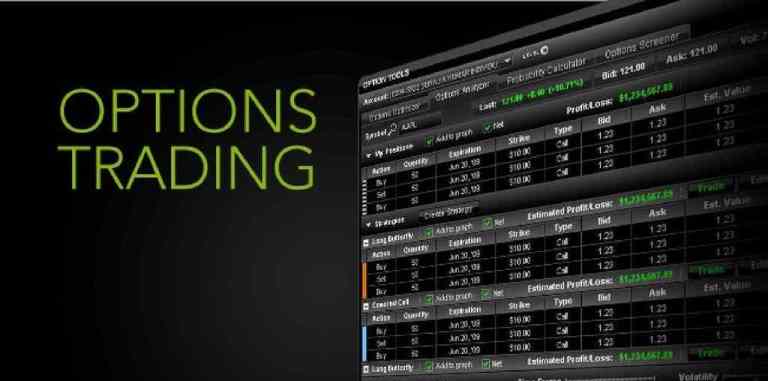📈📈 The 4 Advantages of Options
 Exchange-traded options first started trading back in 1973. Although they have a reputation for being risky investments only expert traders can understand, options can be useful to the individual investor. Here we'll look at the advantages offered by options and the value they can add to your portfolio.
Exchange-traded options first started trading back in 1973. Although they have a reputation for being risky investments only expert traders can understand, options can be useful to the individual investor. Here we'll look at the advantages offered by options and the value they can add to your portfolio.The Advantages of Options
They have been around for more than 40 years, but options are just now starting to get the attention they deserve. Many investors have avoided options, believing them to be sophisticated and, therefore, too difficult to understand. Many more have had bad initial experiences with options because neither they nor their brokers were properly trained in how to use them. The improper use of options, like that of any powerful tool, can lead to major problems.
Finally, words like "risky" or "dangerous" have been incorrectly attached to options by the financial media and certain popular figures in the market. However, it is important for the individual investor to get both sides of the story before making a decision about the value of options.
There are four key advantages (in no particular order) options may give an investor:
- They may provide increased cost efficiency;
- They may be less risky than equities;
- They have the potential to deliver higher percentage returns; and
- They offer a number of strategic alternatives.
With advantages like these, you can see how those who have been using options for a while would be at a loss to explain options' lack of popularity. Let's look into these advantages one by one. (For related information, see: Options Basics Tutorial.)
1. Cost Efficiency
Options have great leveraging power. As such, an investor can obtain an option position similar to a stock position, but at a huge cost savings. For example, to purchase 200 shares of an $80 stock, an investor must pay out $16,000. However, if the investor were to purchase two $20 calls (with each contract representing 100 shares), the total outlay would be only $4,000 (2 contracts x 100 shares/contract x $20 market price). The investor would then have an additional $12,000 to use at his or her discretion.
Obviously, it is not quite as simple as that. The investor has to pick the right call to purchase (a topic for another discussion) to mimic the stock position properly. However, this strategy, known as stock replacement, is not only viable but also practical and cost-efficient. (For more, see: Using Options Instead Of Equity.)
Example
Say you wish to purchase Schlumberger (SLB) because you think it will be going up over the next several months. You want to buy 200 shares while SLB is trading at $131; this would cost you a total of $26,200. Instead of putting up that much money, you could have gone into the options market, picked the option mimicking the stock closely and bought the August call option, with a strike price of $100, for $34. To acquire a position equivalent in size to the 200 shares mentioned above, you would need to buy two contracts. This would bring your total investment to $6,800 (2 contracts x 100 shares/contract x $34 market price), as opposed to $26,200. The difference could be left in your account to gain interest or be applied to another opportunity providing better diversification potential, among other things.
Say you wish to purchase Schlumberger (SLB) because you think it will be going up over the next several months. You want to buy 200 shares while SLB is trading at $131; this would cost you a total of $26,200. Instead of putting up that much money, you could have gone into the options market, picked the option mimicking the stock closely and bought the August call option, with a strike price of $100, for $34. To acquire a position equivalent in size to the 200 shares mentioned above, you would need to buy two contracts. This would bring your total investment to $6,800 (2 contracts x 100 shares/contract x $34 market price), as opposed to $26,200. The difference could be left in your account to gain interest or be applied to another opportunity providing better diversification potential, among other things.
2. Less Risk
There are situations in which buying options is riskier than owning equities, but there are also times when options can be used to reduce risk. It really depends on how you use them. Options can be less risky for investors because they require less financial commitment than equities, and they can also be less risky due to their relative imperviousness to the potentially catastrophic effects of gap openings. (To learn more, see: Do stop or limit orders protect you against gaps in a stock's price?)
Options are the most dependable form of hedge, and this also makes them safer than stocks. When an investor purchases stocks, a stop-loss order is frequently placed to protect the position. The stop order is designed to stop losses below a predetermined price identified by the investor. The problem with these orders lies in the nature of the order itself. A stop order is executed when the stock trades at or below the limit as indicated in the order.
For example, let's say you buy a stock at $50. You do not wish to lose any more than 10% of your investment, so you place a $45 stop order. This order will become a market order to sell once the stock trades at or below $45. This order works during the day, but it may lead to problems at night. Say you go to bed with the stock having closed at $51. The next morning, when you wake up and turn on CNBC, you hear that there is breaking news on your stock. It seems the company's CEO has been lying about the earnings reports for quite some time now, and there are also rumors of embezzlement. The stock is expected to open down around $20. When that happens, $20 will be the first trade below your stop order's $45 limit price. So, when the stock opens, you sell at $20, locking in a considerable loss. The stop-loss order was not there for you when you needed it most.
Had you purchased a put option for protection, you would not have suffered the catastrophic loss. Unlike stop-loss orders, options do not shut down when the market closes. They give you insurance 24 hours a day, seven days a week. This is something stop orders can't do. This is why options are considered a dependable form of hedging.
Furthermore, as an alternative to purchasing the stock, you could have employed the strategy mentioned above (stock replacement), where you purchase an in-the-money call instead of purchasing the stock. Some options mimic up to 85% of a stock's performance, but cost one-quarter the price of the stock. If you had purchased the $45 strike call instead of the stock, your loss would be limited to what you spent on the option. If you paid $6 for the option, you would have lost only $6, not the $31 you'd lose if you owned the stock. The effectiveness of stop orders pales in comparison to the natural, full-time stop offered by options. (To learn more, see: Make Your Portfolio Safer With Risky Investments.)
3. Higher Potential Returns
You don't need a calculator to figure out if you spend less money and make almost the same profit, you'll have a higher percentage return. When they pay off, that's what options typically offer to investors.
For example, using the scenario from above, we'll compare the percentage returns of the stock (purchased for $50) and the option (purchased at $6). Let's say the option has a delta of 80, meaning the option's price will change 80% of the stock's price change. If the stock were to go up $5, your stock position would provide a 10% return. Your option position would gain 80% of the stock movement (due to its 80 delta), or $4. A $4 gain on a $6 investment amounts to a 67% return—much better than the 10% return on the stock. Of course, when the trade doesn't go your way, options can exact a heavy toll: there is the possibility you will lose 100% of your investment. (For related reading, see: Understanding Option Pricing.)
4. More Strategic Alternatives
The final major advantage of options is they offer more investment alternatives. Options are a very flexible tool. There are many ways to use options to recreate other positions. We call these positions synthetics.
Synthetic positions present investors with multiple ways to attain the same investment goals, which can be very useful. While synthetic positions are considered an advanced option topic, options offer many other strategic alternatives. For example, many investors use brokers who charge a margin when an investor wants to short a stock. The cost of this margin requirement can be quite prohibitive. Other investors use brokers who simply do not allow for the shorting of stocks, period. The inability to play the downside when needed virtually handcuffs investors and forces them into a black-and-white world while the market trades in color. But no broker has any rule against investors purchasing puts to play the downside, and this is a definite benefit of options trading.
The use of options also allows the investor to trade the market's "third dimension," if you will—no direction. Options allow the investor to trade not only stock movements, but also the passage of time and movements in volatility. Most stocks don't have large moves most of the time. Only a few stocks actually move significantly, and they do it rarely. Your ability to take advantage of stagnation could turn out to be the factor deciding whether your financial goals are reached or they remain simply a pipe dream. Only options offer the strategic alternatives necessary to profit in every type of market.
The Bottom Line
Having reviewed the primary advantages of options, it's evident why they seem to be the center of attention in financial circles today. With online brokerages providing direct access to the options markets and insanely low commission costs, the average retail investor now has the ability to use the most powerful tool in the investment industry just like the pros do. So, take the initiative and dedicate some time to learning how to use options properly. It is the dawn of a new era for individual investors. Don't get left behind!
BY
BY




For every investor, I would say that trading options have both pros and cons. Although, it's easier to make an incredible gain if you're right about your stock pick. Before investing make sure you understand fully how options work.
ReplyDeleteHonestly, I'm going to tell you all... I've traded options for the last couple of years. There's nothing better. Options allow you to spend way less capital to acquire a lot more stock. I highly suggest learning how to trade options as soon as possible.
ReplyDeleteThaank you for sharing
ReplyDelete